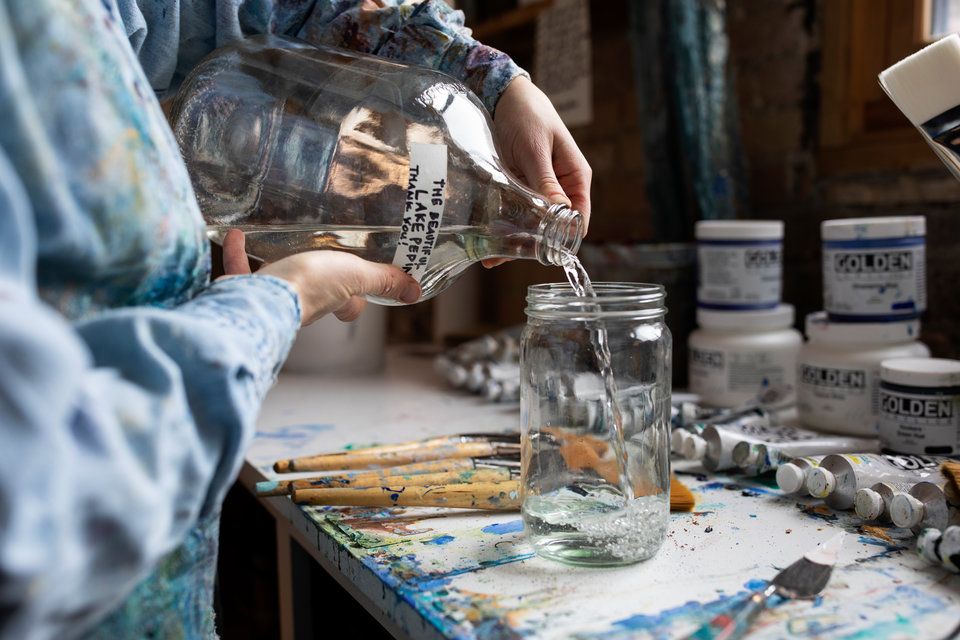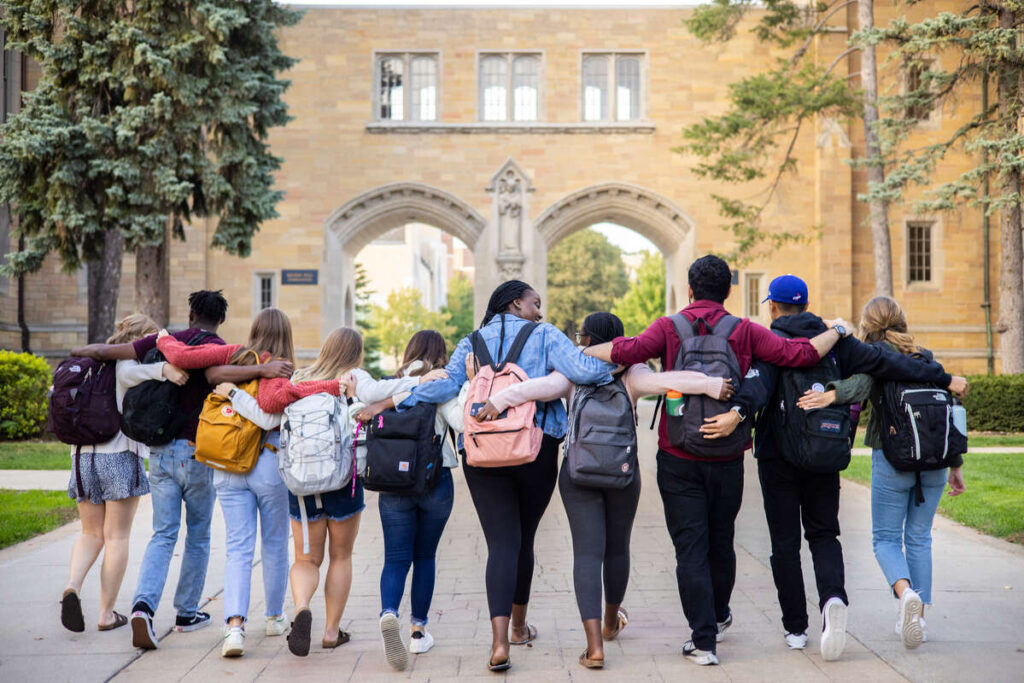The mystery of water – its dark currents and light-filtering waves – flows into Annie Hejny’s paintings. She collects water and sediment from local lakes and rivers, combining them with acrylic paints to create textured abstract images evoking the water from which they came.
“I could just take water from the tap, but I wanted to connect in some way with the source,” Hejny said. “I want to work in a way that is very authentic to that place.”
Hejny appreciates the surprises working with nature present.
“My painting feels intuitive. I’m layering colors, but I’m following what the sediment and water have laid out," she said. "I have developed my technique, but I don’t always know what it’s going to look like.”
Her artwork has evolved since her undergraduate days at St. Thomas, where she majored in elementary education and art. Since then, she has completed nearly 50 commissioned projects for galleries, private collections and public institutions, locally and nationally. Her current exhibit, “Riverlines,” will be on display at the Mississippi Watershed Management Organization in Minneapolis through July 1, 2019.
In the studio
With a four-by-four foot canvas positioned on the floor of her Minneapolis studio, Hejny places netting over it. She sprinkles sand and sediment onto it and slowly pours water from the same lake. Then she adds acrylic paint over some areas. After removing the netting and letting the paint dry, she moves the canvas to an easel. Lastly, she sands down the dried, rough edges and adds more color.
This is the process for her “Waterlines” and “Riverlines” series.
Hejny prefers to gather water from different outlets. “It’s about the spirit and the story of that place," she said. "It’s about going somewhere and paying attention to what’s happening in that moment, whether I’ve trekked down a hill to get to a shoreline or I’m at a cabin. It depends on what’s happening with the water in that setting. I feel that each place has a different kind of voice to it.”
The color of a body of water and the way it flows vary. “So that’s what I work to express in my paintings,” Hejny said. “And it’s really about being connected to a place.”
Early roots
Hejny’s awareness of her surroundings and the environment always have been part of her life.
“It started with the way I grew up, where my parents said, ‘Don’t waste water. Turn off the lights. Recycle,’” said Hejny, who grew up in Mahtomedi, Minnesota. “Those simple but powerful messages as a child helped me think, ‘What impact is this making?’”
Her connection with water started at her family’s cabin on Grindstone Lake in Sandstone, Minnesota.
"It’s where I learned how to swim and ski. I would spend time with goggles on just looking at the bottom of the lake hunting for treasures,” she said. “Because that water is connected to my family, it is special.”
In later journeys, she learned about different cultures and their relationship with the environment. At St. Thomas, she was involved in VISION, a student international volunteer program. She traveled with the program each January and spring break for four years to volunteer in India, Laos, the Virgin Islands, Mississippi, Kentucky, Montana and Texas.
“When I was in Laos, we were in a remote village in the mountains and they had no running water, so it was carefully collected every day,” she said. “I learned that water is precious and to use it wisely.
“I look back on those VISION experiences as being very important for setting myself up with values I align with now and learning how to integrate those into connection and community,” Hejny said. “Jacob Cunningham [VISION director] was a really big inspiration for me and several leaders from that program are still dear friends. VISION was outstanding in my college experience.”
From teacher to artist
Hejny fell in love with school in second grade and decided to become a teacher. She continued working toward that dream when she started her undergraduate studies at St. Thomas in 2007. When she learned that an elementary education degree required a second major, she decided to add a studio art major with classes offered by St. Catherine University.
“My two advisers [one in each major] worked out a schedule so I could graduate in five years, and it was so worth it,” Hejny said.
She credits School of Education adjunct professor Anne Howard with finding her a great placement for her student teaching semester and giving her the tools to succeed in the classroom.
“She showed me how to teach creatively with kids. When I implemented the games and activities she taught me into my student teaching experiences, they worked! It brought me a sense of joy and real connection with kids,” Hejny said.
In the end, her call to become an artist, rather than a teacher, won out.
Into the woods
In college, Hejny focused her paintings on her surroundings – cityscapes. About five years ago, she began her Waterlines series, for which she’s most well-known. Recently, she began exploring a new landscape – the forest.
“Water is special to me, even though I’m transitioning into new work,” Hejny said. “Like many artists, I need to keep expanding my voice.
“I was walking in the woods and it felt really new and exciting,” she continued. “There was this potency and this calling from the trees.”
Hejny is exploring a new body of work about those trees, starting with birch bark skins she gathered from dead trees. She attached them to her studio wall and is sketching them in charcoal.
“It feels exciting and vulnerable to be putting out something very different because I created such a strong voice with the water,” Hejny said.
She plans to create seven pieces, 6 feet by 4 feet, which will be displayed at Form + Content Gallery in Minneapolis. Her exhibition, “Betula,” opens on Thursday, June 27.
Surrounded by Lake Superior and the Gunflint Trail, there’s no doubt she will find plenty of inspiration.










